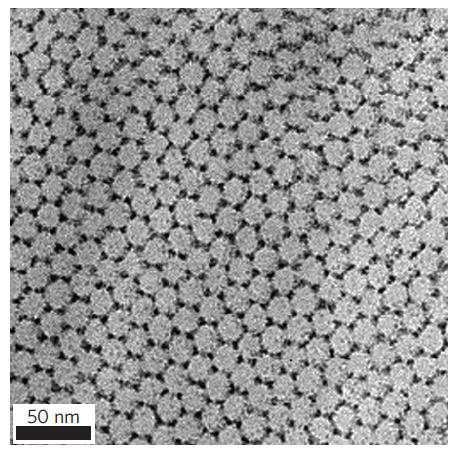APPLICATIONS OF TECHNOLOGY:
- Electronics (semiconductors, capacitors, etc.)
- Photovoltaics
- Optical devices
- Coatings
- Surface plasmon resonance sensors
ADVANTAGES:
- Simple procedure
- Compatible with existing fabrication technology
- Applicable over multiple length scales
- Applicable with various nanoparticle types
ABSTRACT:
Ting Xu and colleagues at Berkeley Lab have developed a simple and versatile method for precisely controlling the spatial distribution of nanoparticles over multiple length scales, from nanometers to meters. The Berkeley Lab technology uses a combination of block copolymers (BCPs) and small molecules to direct nanoparticle assembly without altering the chemical structure and properties of the individual nanoparticles. Furthermore, external stimuli, such as light and heat, can be used to reversibly vary the inter-particle ordering, spatial distribution, and packing density. This enables control over the optical, electronic, and magnetic properties of the final product. The technique requires only the mixing of ingredients under proper conditions, so it is simple, compatible with existing technology, and applicable to various types of nanoparticles.
BCPs are self-assembling strings of repeating units (polymers or microdomains) composed of smaller repeating units (monomers). In this technique, BCPs are reversibly linked to small molecules that direct the assembly to nanoparticles via ligands. Different small molecules can be chosen so that the thermodynamics of the mixture result in desired patterns on the microscopic and macroscopic levels.
To test the method, the scientists fabricated composites using the BCP polystyrene-block-poly-4-vinylpyridine (PS-b-P4VP) and the nanoparticles cadmium selenide and lead sulfide, among others. Transmission electron microscopy and small angle x-ray scattering confirmed that the spatial organization of the nanoparticles in the composites could be controlled with high precision. In addition, temperature could be used to alter the local particle organization and the assembly dimensionality, for example, from lamellae (thin layers) to hexagonally packed cylinders. In the past, other approaches have been limited because they involve chemically modifying the surface and, thus, the properties of the particles. The Berkeley Lab method overcomes this significant shortcoming.


DEVELOPMENT STAGE: Proven principle.
STATUS: Patent pending. Available for licensing or collaborative research.
SEE THESE OTHER BERKELEY LAB TECHNOLOGIES IN THIS FIELD:
Modifying Nanocrystal Surfaces for Molecular Imaging and Electrical Devices, IB-2616
REFERENCE NUMBER: JIB-2662
